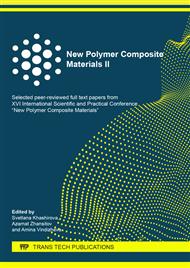p.362
p.367
p.375
p.382
p.388
p.394
p.400
p.408
p.413
Development of Approaches for Producing Polymeric Composite Materials with Higher Strength
Abstract:
In laboratory conditions, oriented polypropylene composite materials containing various concentrations of anisotropic carbon nanoparticles (nanofibers, nanotubes) were obtained. The change in the mechanical properties of oriented composites is determined. Based on structural studies, it was shown that the increase in strength in oriented composites is associated with the formation of a more perfect supramolecular structure of the polymer matrix due to the introduction of low concentrations of nanofillers.
Info:
Periodical:
Pages:
388-393
Citation:
Online since:
October 2020
Authors:
Price:
Сopyright:
© 2020 Trans Tech Publications Ltd. All Rights Reserved
Share:
Citation:


